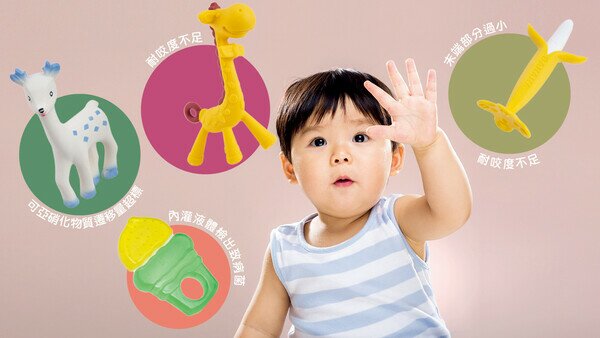Chewing and savoring teether can relieve the discomfort in children during teething and can also reduce the risk of baby eating dirty or dangerous objects. The Consumer Council has tested 20 baby teethers and the results revealed the quality of some models are relatively poor. 2 models contained harmful or carcinogenic N-nitrosamines and/or N-nitrosatable substances. The total migration of N-nitrosatable substances in the most expensive model far exceeded 8 times of the European Standard’s recommended upper limit. Bite durability in 2 models are unsatisfactory. They were unable to withstand a bite which simulate a child aged 18 months or younger and were broken. Among them, the end part of 1 model was too small which could be put too deep in a baby’s throat posing suffocation hazard. In addition, the total aerobic microbial count in the liquid filled inside 1 model far exceeded 339 times of the limit recommended in the European Toy Safety Directive. All test findings have been referred to Customs and Excise Department (C&ED) for follow up. The Council advised manufacturer to immediately improve the design and production process of teethers so as to ensure compliance of various safety standards and to minimize the potential health hazard to children.
The test examined 20 baby teethers in the market, including 13 non-liquid filled teethers and 7 liquid filled teethers. The price of non-liquid filled teethers were relatively higher, ranged from $36 to $139 while the price of liquid filled teethers ranged from $18 to $59. However, the overall performance of the models varied significantly. 3 non-liquid filled teether models and 1 liquid filled teether models, including the most expensive model, rated only 1 or 1.5 points. The other 16 models rated 4 to 5 points. The test evaluated the construction, durability of bite, the amount of harmful chemical substances and the total microbial count as well as checking the comprehensiveness on the labels of the models.
Durability of bite on teether is critical. Taking reference to U.S. Code of Federal Regulations, models were placed under the simulator of baby’s teeth. 25 pounds and 50 pounds of force for 10 seconds were exerted on the models respectively. The simulation imitated a bite of a child aged 18 months or younger and a child aged between 18 months and 3 years old respectively. Results showed that 2 models did not pass the test. Some parts broke out from the models after 25 pounds of force was exerted that could be swallowed by infants accidentally that might cause impaction or suffocation. Among them, 1 model did not comply with the requirement of the European Toy Safety Standard EN71-1 with its end being too small that baby could swallow easily or it may even go deep inside its throat to block the pharynx, posing impaction or suffocation hazard.
Regarding the chemical hazard, with reference to the European Toy Safety Standard EN71-12:2016, the total migration of N-nitrosamines in each toy should not be higher than 0.01mg/kg and the total migration of N-nitrosatable substances should not be higher than 0.1mg/kg. The test revealed that 2 models were found to contain N-nitrosamines and/or N-nitrosatable substances. The total migration of N-nitrosatable substances in 1 model is 0.94 mg/kg, exceeding 8 times of the prescribed maximum limit (0.1mg/kg).
N-nitrosatable substances are the precursors of N-nitrosamines. N-nitrosatable substances may be converted to carcinogenic N-nitrosamines in acidic environment such as a stomach through oral absorption. The Council advised that manufacturers should use appropriate vulcanization accelerators to minimize the production of N-nitrosamines and N-nitrosatable substances in order to safeguard children’s health.
The test also reviewed the hygienic safety level in the liquid filled inside 7 teether models which 1 model was found substandard. The detected total aerobic microbial count in the model was 340,000CFU/ml, far exceeding prescribed limit (1,000CFU/ml) of NB-Toys Recommendations under the European Toy Safety Directive by 339 times. The model was found to contain Enterobacteriaceae and Pseudomonas aeruginosa and the amount of Enterobacteriaceae was more than the recommended limit (100CFU/ml). Given their immature immune system, if infants swallow or contact any liquid with large quantity of microorganisms and pathogens, it may cause bacterial infection leading to gastroenteritis or fever etc.
Despite the fact that liquid is generally filled and sealed inside teether, it could leak due to ageing of outer material or product rupture and baby could possibly be contacted or swallowed the leaked liquid. The Council urges manufacturers to pay attention to the hygiene of liquid inside the teether during production, and suggests to display the manufacturing date on the label. When purchasing this kind of product, consumers should not only make sure the product packaging is intact and inspect the product condition cautiously, but should also take note that liquid filled teethers are generally labelled as cannot be sterilized by high temperature, if they are put into boiling water, steamers or microwave ovens for sterilization, different extent of damage, rupture or deformation may be resulted, causing leakage of filled liquid.
Consumers should pay close attention to their babies when using teether, and pay heed to the following:
- Read the product manual carefully to understand the safety precautions, and to clean or sterilize according to instructions;
- Before and after using, wash baby teether with mild soap water and rinse thoroughly;
- Examine teether carefully, dispose of it if any cracks or leaking is found;
- Never put gel-filled or liquid filled teether in freezer, as frozen teether will not only damage baby’s gum easily and that outer material of teether may rupture under low temperature;
- Do not use string or band to tie the teether around baby’s neck to prevent accident;
- If the baby is choking, call 999 for emergency help immediately or send the baby to Accident and Emergency for treatment.
The Consumer Council reserves all its right (including copyright) in respect of CHOICE magazine and Online CHOICE.



